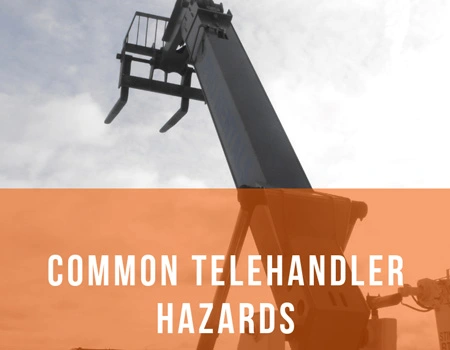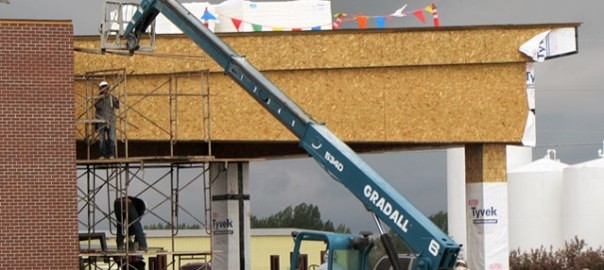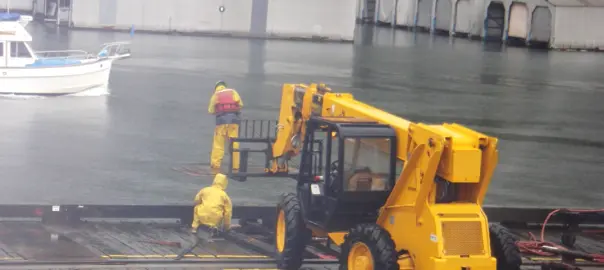
With autumn in full swing, working outside during the harvest season seems like a picturesque and tranquil job. However, getting into an accident on a telehandler turns a job from serene to life-threatening in an instant. Knowing common telehandler hazards will not only make you more informed, but could potentially save your life.
Top 6 Telehandler Hazards
- Struck by Forklift. This type of injury is unfortunately as dangerous as it is common. The Centers for Disease Control and Prevention says that 36% of forklift victims die from forklifts hitting them. Always be aware of pedestrians near your machine and have well-placed mirrors to reduce blind spots.
- Hit by Falling Load. Fall is a beautiful season, but having 200 pounds of metal piping fall on you is not. This often happens when loads are not shrink-wrapped, stacked too high, or not properly secured to the forklift. Be sure to properly secure your load and avoid working under suspended loads.
- Tipped Over. Telehandlers have to obey the laws of gravity, especially when the conditions are perfect for tipping over. Overloading is the most common cause of this fatal injury, so never load the forklift up heavier than its capacity. If your forklift starts to tip over, wear your seat belt, stay in your seat, brace your feet and lean forward. Do not jump!
- Elevated Personnel. You shouldn’t have to ask yourself if you would survive a 22-foot fall from a telehandler. Be smart and always wear fall protection, and avoid being elevated in uneven terrain. You can learn about other ways to protect yourself in Safety Provision’s Telehandler Training.
- Power Line Contact. Any metal contact with a power line can cause injuries and death. Many of these accidents occur because workers initially failed to identify the power line as a hazard. You can prevent this by keeping your forklift at least 10 feet away and marking the area as dangerous.
- Obstruction of Vision. Though Stevie Wonder can play the piano without his sight, yours is essential to operating telehandlers. Blind spots in the back, the boom and even the load itself can obstruct your vision. As mentioned before, install well-placed mirrors and grab a spotter if you can’t see properly.

Spot the Safety Hazards:
Telehandler and Scaffolding Hazard Analysis:
Telehandlers, or reach forklifts, are used in so many ways. They can be very handy around any construction site, and this case was no different . . . except for a couple things.
First, the scaffolding was not set up correctly. Mud sills were missing under a few base plates. If you are setting up on soil, you must use mud sills, there is no way around it. Much like outrigger pads for mobile cranes, they are there to keep things stable. In addition to the missing mud sills, the scaffolding lacked toe boards and sufficient guardrails. And on the top level, one of the planks was less than 9 inches wide. Regulations state that the planks must be 9 – 12 inches wide.
Aside from the scaffolding though, there were a couple potential problems introduced by the interaction between telehandler and scaffolding, and the workers on both. In this case, the telescopic handler was lifting boards up to the worker on the second tier o the scaffolding, but the planks on the forks were too high. As a result, the worker on the scaffolding was having to climb the unsecured scaffold tubing to reach the boards. This could have led to a fall. Another time, when extending the boom, the reach forklift operator bumped the scaffold. Luckily nothing happened, but if you are ever in a situation where your depth perception is limited, consider using a spotter to help you deliver the load. Designated hand signals is another way to communicate with each other. It is interesting to note that among the most cited OSHA Requirements on construction sites, communications and scaffolding are numbers 2 and 3, respectively.
Lastly, while they are hard to see in this picture, there are some electric wires nearby. If working near power lines, you must make sure the lines are de-energized or you keep your distance as required by your standards. Typically, most standards require you to stay at least ten feet away from a 50 kv line.

Spot the Safety Hazards:
Telehandler Hazard Analysis:
Where do we start, right? There were, in fact, several issues here, but let’s address the most obvious.
First, while it may seem like a small thing, the weather here is a problem, especially for how they are using the forklift. It’s great that one guy is wearing a hard hat, but what good is it going to do if he slips and falls into the water? Second, while it is not as obvious from the picture, this particular dock was in bad shape. Several boards showed signs of imminent failure. Never drive a telehandler over a dock, a grate, or any other surface if it has not first been load rated or if you are unsure of its load rating. Nor should you work on docks or over water unless trained for this purpose. Here, we can rightly assume these two operators lacked sufficient training and supervision.
Second, regulations and manufacturer guidelines clearly state that in no instance should anyone ever ride on or stand on the forks or a load. It doesn’t matter if the forklift is stationary, mobile, or in the midst of lifting a load; it is a violation of safety standards and just plain dangerous. In this case, one might argue that the operator was not, in actuality, standing on the forks and, furthermore, that by placing two sheets of plywood across the forks, he was not in danger of falling. But you and I both know that is not true. Sure, he might be more stable than if balanced precariously on a wet tine, but because of the lack of fall protection and because of the stormy conditions, he is still in danger of slipping and falling into the water.
On that note, where is his fall protection? The hose he is hanging onto would not be enough to brake his fall. According to regulations, if there is no other, more plausible way to lift a worker into the air (like using a boom lift), then work platforms (also known as man baskets) can be attached to a telehandler or forklift provided the brand and capacity are approved by the manufacturer of the telescopic handler being used. Just because you have a JLG basket doesn’t mean you can use it with a JLG telehandler, unless you first get the manufacturer’s approval.
In this case, they should have used a boom lift or taken the time to properly secure an approved work platform. Then the worker should have taken the additional time to put on fall arrest gear and tie into the designated anchor point.
To be honest, despite how stupid and dangerous this is, this type of situation is something we see all of the time. There is something in our nature, it seems, that makes a game out of finding ways to get things done when we don’t have the proper tools to do it right. But that is no excuse for dangerous behavior. Take the time and even spend the money, if you have to, to do the job right and safely the first time. It sounds cliche, but lives do depend on it.
Conclusion
Gaining proper training and being aware of the hazards in your workplace can sometimes seem like a daunting task. Luckily, Hard Hat Training has worked hard to provide thorough and accurate safety training to give you peace of mind. After all, no one wants to spend a beautiful October day in a hospital bed!
